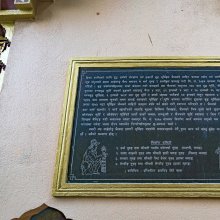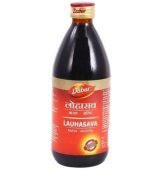Sam, Sām, Sham, Śam: 18 definitions
Introduction:
Sam means something in Buddhism, Pali, Hinduism, Sanskrit, the history of ancient India, Marathi, Jainism, Prakrit, Hindi, biology, Tamil. If you want to know the exact meaning, history, etymology or English translation of this term then check out the descriptions on this page. Add your comment or reference to a book if you want to contribute to this summary article.
The Sanskrit term Śam can be transliterated into English as Sam or Sham, using the IAST transliteration scheme (?).
Images (photo gallery)
In Hinduism
Vyakarana (Sanskrit grammar)
Source: Wikisource: A dictionary of Sanskrit grammarSām (साम्).—The case-ending(आम् (ām)) of the genitive plural with the augment स् (s) prefixed; cf. साम आकम् (sāma ākam) P.VII. 1.33.

Vyakarana (व्याकरण, vyākaraṇa) refers to Sanskrit grammar and represents one of the six additional sciences (vedanga) to be studied along with the Vedas. Vyakarana concerns itself with the rules of Sanskrit grammar and linguistic analysis in order to establish the correct context of words and sentences.
In Buddhism
Theravada (major branch of Buddhism)
Source: Journey to Nibbana: Patthana Dhamasam means well;
Theravāda is a major branch of Buddhism having the the Pali canon (tipitaka) as their canonical literature, which includes the vinaya-pitaka (monastic rules), the sutta-pitaka (Buddhist sermons) and the abhidhamma-pitaka (philosophy and psychology).
India history and geography
Source: Cologne Digital Sanskrit Dictionaries: Indian Epigraphical GlossarySaṃ.—(IE 8-1), abbreviation of saṃbaddha, ‘attached to’, ‘belonging to,’ etc.; possibly also saṃsakta, ‘relating to’ (JAS, Letters, Vol. XX, p. 204). (CII 3, 4), abbreviation of the word saṃvatsara, a year, or of its declensional cases that can be used in expressing a date. Note: saṃ is defined in the “Indian epigraphical glossary” as it can be found on ancient inscriptions commonly written in Sanskrit, Prakrit or Dravidian languages.
--- OR ---
Saṃ.—(PJS), also written Saṃgha; contraction of Saṃghavī or Saṃghapati in medieval Jain inscriptions; same as the modern Jain family name Siṅghī. Note: saṃ is defined in the “Indian epigraphical glossary” as it can be found on ancient inscriptions commonly written in Sanskrit, Prakrit or Dravidian languages.
--- OR ---
Sāṃ.—(IE 8-1; LP), abbreviation of sāṃvatsarika, annual. See sāṃ-hi. Note: sāṃ is defined in the “Indian epigraphical glossary” as it can be found on ancient inscriptions commonly written in Sanskrit, Prakrit or Dravidian languages.
--- OR ---
Śam.—(ML) ‘to prevent’. Note: śam is defined in the “Indian epigraphical glossary” as it can be found on ancient inscriptions commonly written in Sanskrit, Prakrit or Dravidian languages.
Source: Shodhganga: Deforestation in Nagaland: a historical perspectiveSam is the name of a plant corresponding to Artocarpus integrifolia — Koth, according to the author Lanukumla Ao in his thesis “Deforestation in Nagaland”, mentioning the source: Annual Administrative Report 2012-2013.

The history of India traces the identification of countries, villages, towns and other regions of India, as well as mythology, zoology, royal dynasties, rulers, tribes, local festivities and traditions and regional languages. Ancient India enjoyed religious freedom and encourages the path of Dharma, a concept common to Buddhism, Hinduism, and Jainism.
Biology (plants and animals)
Source: Google Books: CRC World Dictionary (Regional names)1) Sam in India is the name of a plant defined with Artocarpus chama in various botanical sources. This page contains potential references in Ayurveda, modern medicine, and other folk traditions or local practices It has the synonym Artocarpus chama Buch.Ham. ex Wall. (among others).
2) Sam is also identified with Bombax ceiba It has the synonym Salmalia malabarica Schott. & Endl.) (Gossampinus Schott & Endl., a variant of gossympinus, a Latin name used by Plinius for the cotton tree, Gossypium arboreum L. (etc.).
Example references for further research on medicinal uses or toxicity (see latin names for full list):
· Taxon (1979)
· Ethnobotany (2004)
· FBI (1874)
· Hortus Bengalensis (1814)
· Taxon (1977)
· Flora Indica, or ‘Descriptions of Indian Plants’ (1832)
If you are looking for specific details regarding Sam, for example diet and recipes, extract dosage, pregnancy safety, side effects, chemical composition, health benefits, have a look at these references.

This sections includes definitions from the five kingdoms of living things: Animals, Plants, Fungi, Protists and Monera. It will include both the official binomial nomenclature (scientific names usually in Latin) as well as regional spellings and variants.
Languages of India and abroad
Marathi-English dictionary
Source: DDSA: The Molesworth Marathi and English Dictionarysam (सम्).—(S) A particle and prefix implying I. Union or junction (with, together). II. Assemblage or collection. III. Beauty, excellence, rightness. IV. Intensity. As a prefix it corresponds with Con, com, col, cor, co. Before a consonant the final of this word is changed to Anuswar, and the word is written saṃ. Ex. saṃlagna, sammōhita, sañjāta.
Source: DDSA: The Aryabhusan school dictionary, Marathi-English1) Sāṃ (सां).—or sāṃ ad Imit. of the sound of gulping eagerly; also of crying copiously.
2) sāṃ (सां).—or-sāṃ ad Imitative sounds of walking over sand, in thick mud &c.; of staling or urining copiously; of the hissing, singing, or fizzing of substances under fermentation.
3) sāṃ (सां).—or-sāṃ ad Spittingly, hissingly, snappishly &c.
4) sāṃ (सां).—or-sāṃ ad Imit. of replying to sharply and petulantly v bōla, aṅgāvara yē.
Marathi is an Indo-European language having over 70 million native speakers people in (predominantly) Maharashtra India. Marathi, like many other Indo-Aryan languages, evolved from early forms of Prakrit, which itself is a subset of Sanskrit, one of the most ancient languages of the world.
Sanskrit dictionary
Source: DDSA: The practical Sanskrit-English dictionaryŚam (शम्).—ind. A particle meaning welfare, happiness, prosperity, health, and generally used to express a blessing or pious wish, (with dat. or gen.); शं देवदत्ताय (śaṃ devadattāya) or देवदत्तस्य (devadattasya) (often used in modern letters as an auspicious conclusion; iti śam).
--- OR ---
Sam (सम्).—ind.
1) As a prefix to verbs and verbal derivatives it means (a) with, together with, together; as in संगम्, संभाषण, संधा, संयुज् (saṃgam, saṃbhāṣaṇa, saṃdhā, saṃyuj) &c.). (b) Sometimes it intensifies the meaning of the simple root, and may be translated by 'very, quite, greatly, thoroughly, very much'; संतुष्, संतोष, संन्यस्, संन्यास, संता (saṃtuṣ, saṃtoṣa, saṃnyas, saṃnyāsa, saṃtā) &c, तस्या- मात्मानुरूपायामात्मजन्मसमुत्सुकः (tasyā- mātmānurūpāyāmātmajanmasamutsukaḥ) R.1.33. (c) It also expresses completeness, perfection, or beauty.
2) As prefixed to nouns to form comp. it means 'like, same, similar', as in समर्थ (samartha).
3) Sometimes it means 'near', 'before', as in समक्ष (samakṣa).
4) In the Vedas it is sometimes used as a separable preposition (with instr.).
Source: Cologne Digital Sanskrit Dictionaries: Shabda-Sagara Sanskrit-English DictionaryŚam (शम्).—[(ir u)iraśmu] r. 4th cl. (śāmyati) 1. To be pacified, to be calmed or appeased. 2. To pacify, to calm. 3. To be tranquil, to have the passions tamed and quiescent. r. 10th cl. (śāmayate) To look, to look at or inspect. (śamayati-te) To allay, to appease. (śāmayati) To display. With upa prefixed, To tranquillize, to ally, to tame. With ni, 1. To hear. 2. To observe, to perceive. 3. To restrain or prevent. With pra, 1. To destroy. 2. To be very tranquil. 3. To be soothed. 4. To cease. 5. To fade away. With sam, To be extinguished.
--- OR ---
Śam (शम्).—Ind. A particle meaning “welfare, prosperity, blessing, health,” (with a dat. or gen.)
--- OR ---
Ṣam (षम्).—r. 1st cl. (samati) 1. To be unconfused. 2. To be confused. r. 10th cl. (samayati-te) To perplex or distress.
--- OR ---
Saṃ (सं).—Ind. (In composition,) With, together with, &c.; being the optional form of writing sam before a consonant: before consonants of the first five classes, the Anuswara may be again changed to the nasal of the class to which the letter it preceds belongs, as saṃ for sam and kalpa make saṅkalpa, &c.: before the semi-vowels, the sibilants, and ha, it preferably remains unaltered; this practice however is very arbitrary in this respect and the change is expressed or not, in all manuscripts according to the pleasure of the writer.
--- OR ---
Sam (सम्).—Ind. A particle and prefix implying:—1. Union, junction, (with, together.) 2. Assemblage, collection. 3. Beauty or perfection. 4. Intensity. As a prefix it corresponds to con, co, com, &c. Before a consonant the final of this word is changed to Anuswara, and is written saṃ. E. so-vā0 kamu .
--- OR ---
Sām (साम्).—r. 10th cl. (sāmayati-te) 1. To conciliate, to appease. 2. To pacify, to tranquillize; more properly ṣām .
Source: Cologne Digital Sanskrit Dictionaries: Benfey Sanskrit-English DictionaryŚam (शम्).—i. 4, śāmya, [Parasmaipada.] (the original signification is ‘To get tired’), 1. To cease, Man, 2, 94. 2. To grow calm, to be appeased, Mahābhārata 2, 1936; to grow satisfied and pacified, [Rājataraṅgiṇī] 5, 400. 3. To be calm, undisturbed, Mahābhārata 1, 6362. 4. To sacrifice,
— With the prep. upa upa, 1. To cease, Mahābhārata 4, 1775. 2. To grow quiet, Mahābhārata 3, 1008. [Causal.] śāmaya, 1. To allay, [Daśakumāracarita] in
— With abhyupa abhi-upa, abhyupaśānta, Appeased, [Ṛtusaṃhāra] 1, 1.
— With ni ni, 1. To see, Mahābhārata 2, 1740. 2. To hear, [Rāmāyaṇa] 2, 44, 25. niśānta, Quiet, patient. n. A house, a dwelling, [Raghuvaṃśa, (ed. Stenzler.)] 16, 40. [Causal.] śāmaya, 1. To see, [Rāmāyaṇa] 1, 2, 6. 2. To hear, 2, 57, 21.
— With abhini abhi-ni, [Causal.] śāmaya, To perceive, [Daśakumāracarita] 201, 14.
— With vini vi-ni, To hear, Mahābhārata 3, 1878.
— With saṃni sam-ni, To hear, Mahābhārata 2, 1658. [Causal.] śāmaya, To summon,
— With pari pari, [Causal.] śamaya, To allay, [Gītagovinda. ed. Lassen.] 7, 20.
— With pra pra, 1. To cease, [Rāmāyaṇa] 2, 40, 33; to fade, [Mānavadharmaśāstra] 4, 186. 2. To be restrained, [Pañcatantra] i. [distich] 357; to become extinguished, [Pañcatantra] iii. [distich] 54. 3. To be appeased, soothed,
— With sam sam, saṃśānta, Extinguished, [Rāmāyaṇa] 2, 66, 1. [Causal.] śamaya, To allay, [Rāmāyaṇa] 2, 98, 1; to settle, [Pañcatantra] i. [distich] 421.
— Cf. (cf. ved. śam, ii. 9, śamnā), (cf. śamyā); [Old High German.] chamo.
--- OR ---
Śam (शम्).—I. (sbst.), Work,
--- OR ---
Sam (सम्).—stam Stam, i. 1, [Parasmaipada.] 1. To be unconfused. 2. To be confused. i. 10, samaya, stamaya, [Parasmaipada.] To be confused.
--- OR ---
Sam (सम्).—[sa + m] (acc. sing. n. of sa), 1. prep. With, only in the Veda,
--- OR ---
Sām (साम्).—i. 10 (rather a dénomin. derived from sāman), [Parasmaipada.] To conciliate, to appease.
Source: Cologne Digital Sanskrit Dictionaries: Cappeller Sanskrit-English DictionaryŚam (शम्).—1. śamati śamyati [participle] śamita labour, work; make ready, prepare ([ritual or religion]). — Cf. śaśamāna.
--- OR ---
Śam (शम्).—2. śāmyati śāmyate (śamati), [participle] śānta (q.v.) be quiet, still, or content; be allayed or extinguished; cease, desist, stop. [Causative] śamayati (śāmayati) quiet, still, pacify, allay, extinguish, subdue, destroy, kill.
--- OR ---
Śam (शम्).—3. (śamnīte) harm.
--- OR ---
Śam (शम्).—4. śamayati & śāmayati [with] ni note, perceive, hear, learn.
--- OR ---
Śam (शम्).—5. [indeclinable] (±yos) blessing, welfare, prosperity, happiness.
--- OR ---
Sam (सम्).—[adverb] along with, together (mostly °—).
Source: Cologne Digital Sanskrit Dictionaries: Monier-Williams Sanskrit-English Dictionary1) Śam (शम्):—1. śam [class] 4. [Parasmaipada] ([Dhātupāṭha xxvi, 92]), śāmyati (rarely te, and [Epic] also śamati, te; [Vedic or Veda] śamyati, śimyati, and [class] 9. śamnāti [Naighaṇṭuka, commented on by Yāska ii, 9], śamnīṣe, śamnīthās [imperative] śamnīṣva, śamīṣva, śamiṣva, śamīdhvam; [perfect tense] śaśāma, śemuḥ, [Brāhmaṇa] etc.; śaśame [subjunctive] śaśamate, [Ṛg-veda]; p. śaśamāna q.v.; [Aorist] aśamiṣṭhās, [Ṛg-veda]; aśamat, [Brāhmaṇa] cf. [present tense]; Prec. śamyāt [grammar]; [future] śamitā, śamiṣyati, [ib.]; [indeclinable participle] śamitvā, śāntvā, Samam, [ib.]),
—to toil at, fatigue or exert one’s self ([especially] in performing ritual acts), [Ṛg-veda; Taittirīya-brāhmaṇa];
—to prepare, arrange, [Vājasaneyi-saṃhitā];
—to become tired, finish, stop, come to an end, rest, be quiet or calm or satisfied or contented, [Taittirīya-saṃhitā; Śatapatha-brāhmaṇa] etc.;
—to cease, be allayed or extinguished, [Mahābhārata; Kāvya literature] etc.;
— [class] 9. (cf. above) to put an end to, hurt, injure, destroy, [Kāṭhaka] :—[Passive voice] śamyate ([Aorist] aśami), [Pāṇini 7-3, 34] :—[Causal] śamayati (mc. also śāmayati; [Aorist] aśīśamat; [Passive voice] śāmyate),
—to appease, allay, alleviate, pacify, calm, soothe, settle, [Ṛg-veda] etc. etc.;
—to put to an end or to death, kill, slay, destroy, remove, extinguish. sup. press, [Taittirīya-saṃhitā] etc. etc.;
—to leave off, desist, [Mahābhārata];
—to conquer, subdue, [Kālidāsa; Bhaṭṭi-kāvya] :—[Desiderative] śiśamiṣati [grammar]:—[Intensive] śaṃśamīti ([Bālarāmāyaṇa]), śaṃśamyate, śaṃśanti ([grammar]), to be entirely appeased or extinguished ([perfect tense] śaṃśamāṃ cakruḥ, [Bhaṭṭi-kāvya]). (cf. [Greek] κάμνω),
2) 2. śam ind. ([gana] cādi and svar-ādi) auspiciously, fortunately, happily, well (frequently used in the Veda, rarely in later language; often to be translated by a [substantive], [especially] in the frequent phrase śaṃ yoḥ or śaṃ ca yoś ca, ‘happiness and welfare’, sometimes joined with the verbs bhū, as, kṛ, dā, vah, yā, sometimes occurring without any verb; with [dative case] or [genitive case] cf. [Pāṇini 2-3, 73 [Scholiast or Commentator]]; in some cases corresponding to an [adjective (cf. [masculine, feminine and neuter; or adjective])] e.g. śaṃ tad asmai, that is pleasant to him), [Ṛg-veda]; etc.
3) Śaṃ (शं):—[from śam] in [compound] for 2. śam.
4) Saṃ (सं):—(in [compound]) = sam2 q.v.
5) Sam (सम्):—1. sam or stam [class] 1. [Parasmaipada] samati or stamati, to be disturbed ([according to] to some ‘to be undisturbed’; cf. √śam), [Dhātupāṭha xix, 82];
— [class] 10. [Parasmaipada] samayati or stamayati, to be agitated or disturbed, [Vopadeva]
6) 2. sam ind. (connected with 7. sa and 2. sama, and opp. to 3. vi q.v.) with, together with, along with, together, altogether (used as a preposition or prefix to verbs and verbal derivatives, like [Greek] σύν, [Latin] con, and expressing ‘conjunction’, ‘union’, ‘thoroughness’, ‘intensity’, ‘completeness’ e.g. saṃ√yuj, ‘to join together’; saṃ-√dhā, ‘to place together’; saṃ-dhi, ‘placing together’; saṃ-√tap, ‘to consume utterly by burning’; sam-uccheda, ‘destroying altogether, complete destruction’; in [Vedic or Veda] the verb connected with it has sometimes to be supplied, e.g. āpo agnim yaśasaḥ saṃ hi pūrvīḥ, ‘for many glorious waters surrounded Agni’; it is sometimes prefixed to nouns in the sense of 2. sama, ‘same’; cf. samartha), [Ṛg-veda]; etc.
7) Sām (साम्):—See 1. sāmaya, p. 1205, col. 1.
Source: Cologne Digital Sanskrit Dictionaries: Yates Sanskrit-English Dictionary1) Śam (शम्):—(ya, u) śāmyati 4. a. To be pacified, calm, or tranquil; to pacify. (ka) śamayati 10. a. Idem. śāmayati 10. a. To display. śāmayate 10. d. To inspect. With prep. ā, to tame; ni, to hear; restrain; pra, to destroy.
2) Ṣam (षम्):—samati 1. a. To be unconfused or confused. samayati 10. a. To perplex.
3) Saṃ (सं):—prep. With. In composition before the unclassified letters jña, ya, ra, la, va, śa, sa, ha the final of it is written (ṃ); before a vowel (sam); before a classified letter it is supplied by the nasal of that class which follows; as, saṃjñā, a name; samācāra news; and sañcaya, a collection. In common writing this distinction is much neglected, particularly when compound consonants follow.
4) Sam (सम्):—prep. With. See saṃ.
Source: DDSA: Paia-sadda-mahannavo; a comprehensive Prakrit Hindi dictionary (S)Śam (शम्) in the Sanskrit language is related to the Prakrit words: Paḍisā, Paḍisāma, Parisāma, Saṃ, Sama, Samsa.
[Sanskrit to German]
Sanskrit, also spelled संस्कृतम् (saṃskṛtam), is an ancient language of India commonly seen as the grandmother of the Indo-European language family (even English!). Closely allied with Prakrit and Pali, Sanskrit is more exhaustive in both grammar and terms and has the most extensive collection of literature in the world, greatly surpassing its sister-languages Greek and Latin.
Hindi dictionary
Source: DDSA: A practical Hindi-English dictionary1) Sham in Hindi refers in English to:—(nm) calmness; tranquillity of mind..—sham (शम) is alternatively transliterated as Śama.
2) Sham in Hindi refers in English to:—(nf) evening, dusk; —[ki subaha karana] to keep awake the whole night; -[subaha karana] to evade, to shirk, to dilly-dally..—sham (शाम) is alternatively transliterated as Śāma.
3) Sam in Hindi refers in English to:—(a) even; equal; homogeneous; regular pro-; (nm) even number; first accented beat in a rhythmic cycle; ~[karana] equalisation; ~[kulapati] Pro-Vice-Chancellor (of a University); ~[kuladhipati] Pro-Chancellor; ~[nama] homonym; homonymous; ~[namata] homonymy; ~[pakshiya] homolateral; ~[prarupi] homotypical; ~[prasara] relay; ~[rekhana] alignment; ~[limgarati] homosexuality; ~[shabda] analogue; ~[samajikata] homosociability; ~[svana] homophone..—sam (सम) is alternatively transliterated as Sama.
...
Prakrit-English dictionary
Source: DDSA: Paia-sadda-mahannavo; a comprehensive Prakrit Hindi dictionary1) Saṃ (सं) in the Prakrit language is related to the Sanskrit word: Śam.
2) Saṃ (सं) also relates to the Sanskrit word: Sam.
Prakrit is an ancient language closely associated with both Pali and Sanskrit. Jain literature is often composed in this language or sub-dialects, such as the Agamas and their commentaries which are written in Ardhamagadhi and Maharashtri Prakrit. The earliest extant texts can be dated to as early as the 4th century BCE although core portions might be older.
Tamil dictionary
Source: DDSA: University of Madras: Tamil LexiconŚam (ஶம்) noun < śam. Prosperity. See சம்¹. [sam¹.]
--- OR ---
Sam (ஸம்) particle < sam. A Sanskrit prefix. See சம்². [sam².]
Tamil is an ancient language of India from the Dravidian family spoken by roughly 250 million people mainly in southern India and Sri Lanka.
See also (Relevant definitions)
Starts with (+9980): Cama, Cama-kattunilam, Cama-nilaivenpa, Cama-pataviruttam, Cama-tura-atcarekai, Cama-vatacaivam, Cama-vetacamavayam, Camacakkaram, Camacan, Camacantiran, Camacaram, Camacarapattirikai, Camacattamam, Camacaturam, Camaccirayam, Camaci, Camacittattuvam, Camacokti, Camacuram, Camai.
Ends with (+1376): A-patakecam, Aasam, Abhidosham, Abhighosham, Abhiksham, Abhinisham, Abhisham, Abhrisham, Abhyasham, Acajou bassam, Acajou de bassam, Acajou grand bassam, Acakacam, Acam, Acamancacam, Acariyapurusham, Acaucam, Acavucam, Acchandasam, Acesham.
Full-text (+9226): Shamsa, Sama, Samshanti, Samsita, Samvada, Samsphota, Santati, Shamtva, Samudagama, Shamsana, Samharsha, Samsanana, Samshamana, Shamyos, Samrava, Samanunisham, Samnisham, Samkashya, Shamgavi, Phasaphasa.
Relevant text
Search found 200 books and stories containing Sam, Sām, Sāṃ, Sham, Śam, Saṃ, Ṣam, Śaṃ; (plurals include: Sams, Sāms, Sāṃs, Shams, Śams, Saṃs, Ṣams, Śaṃs). You can also click to the full overview containing English textual excerpts. Below are direct links for the most relevant articles:
Rig Veda (translation and commentary) (by H. H. Wilson)
The Agni Purana (by N. Gangadharan)
Chapter 25 - Worship regarding Vāsudeva, Saṅkarṣaṇa, Pradyumna and Aniruddha
Chapter 164 - The propitiatory rite for the Planets (navagraha-homa)
Chapter 201 - Mode of worshipping Viṣṇu in a figure of nine compartments
Garga Samhita (English) (by Danavir Goswami)
Verse 5.18.30 < [Chapter 18 - Uddhava Hears the Gopīs’ Words and Returns to Mathurā]
Verse 6.4.12 < [Chapter 4 - Journey to the City of Kuṇḍina]
Verse 1.14.7 < [Chapter 14 - The Liberation of Śakaṭāsura and Tṛṇāvarta]
Puranic encyclopaedia (by Vettam Mani)
Women in the Atharva-veda Samhita (by Pranab Jyoti Kalita)
17. Goddess Pṛśni < [Chapter 4 - Female Deities and the Glorification of Women in the Atharvaveda]
15. Goddess Nirṛti < [Chapter 4 - Female Deities and the Glorification of Women in the Atharvaveda]
6a. Hymns to Secure the Love of a Woman < [Chapter 2 - The Strīkarmāṇi Hymns of the Atharvaveda]
Rudra-Shiva concept (Study) (by Maumita Bhattacharjee)
2(f): Epithets relating to Rudra’s auspicious character < [Chapter 2 - Rudra-Śiva in the Saṃhitā Literature]
4. Atharvaveda-saṃhitā (d): Benevolent characters of Rudra < [Chapter 2 - Rudra-Śiva in the Saṃhitā Literature]
1. Ṛgveda (g): Rudra and Soma < [Chapter 2 - Rudra-Śiva in the Saṃhitā Literature]
Related products
(+10 more products available)








